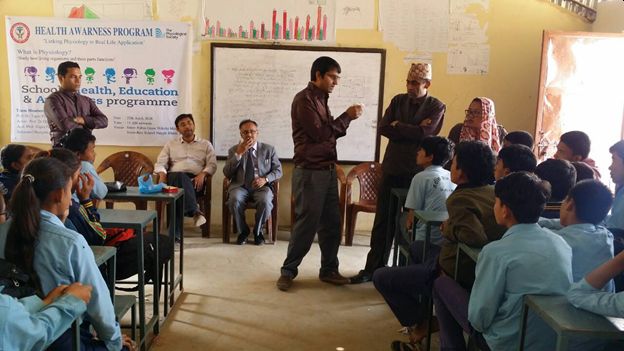
Physiology News Magazine
Making outreach relevant: sharing physiology in a small town in Nepal
Membership
Making outreach relevant: sharing physiology in a small town in Nepal
Membership
Rajan Pandit, Nepal Medical College, Nepal
https://doi.org/10.36866/pn.112.46

To address health awareness and potentiate an interest in physiology among school teachers and students, interactive outreach activities are instrumental. We strongly believe in teaching school teachers, linking physiology knowledge to real-life applications, and establishing good rapport between schools, youth organisations and medical college laboratories. This aims to widen participation and also to open the door to physiology-related study and career options among school students. Moreover, the interaction between the general public, especially those who are traditionally hard to reach, and researchers is imperative to establish a symbiotic relationship: the physiologists share their stories, passions and expertise in innovative ways, and the public can acquire life-changing health tips and knowledge from physiologists.
Nepal, one of the lesser developed countries of the world, is home to surreal geographical beauties. However, due to political upheaval and its challenging geographical location, most of the Nepalese are forced to live in an improvised condition. With generous support from The Physiological Society, we, five team members including school representative Mahesh Pd Timilsina, embarked with utmost zeal on our journey to the school on 27 April 2018. The school, Shree Nabin Gram Shiksha Secondary School, Naglebhare, is about 24 km north-east from central Kathmandu, located around 1,700 m above sea level.
Despite having travelled through muddy, bumpy narrow roads, we were uplifted by a warm welcome by the school authorities. Thee grade 9 and 10 students greeted us with curious eyes, seeing the bizarre instruments we brought with us.
We tailored the discussion around topics relevant to students, and had an interactive component where they had a chance to listen to their own heart sounds and breathing.
Firstly, we asked about their blood type, and most of the students were shy and hesitated to answer. Most of them did not know the answer. Students and even the principal were not aware of how to determine blood type. We demonstrated how to determine blood groups using antisera (A, B and D). Everyone was surprised to see the results.
When we asked them about doing blood transfusion without checking the blood, they knew this was a bad idea. The reason for their objection was the chances of transmission of diseases like AIDS and hepatitis. None of them mentioned blood grouping and cross-matching. We were happy and excited to know they at least had some knowledge on blood transfusion. We filled in the gaps in their knowledge with a brief discussion on the complications associated with mismatched transfusion.
Most of the students’ parents were farmers. Working in the field all day, they often have fainting spells, or syncope, and they do not know how to manage these. We demonstrated how to manage fainting in order to protect against head injury
Following these discussions, we showed the students how to listen to bronchial sounds, heart sounds and the sound of blood flowing (korotkoff). Students were elated to hear those sounds as it was the first time for them.
In the few hours we spent teaching the students, and discussing with them, we hope to have stimulated their interest in physiology. It also taught us how to deliver complex ideas using simpler words. The experience was surreal for us. Our team decided to continue this programme and we hope to get generous support from The Physiological Society in the days to come.
